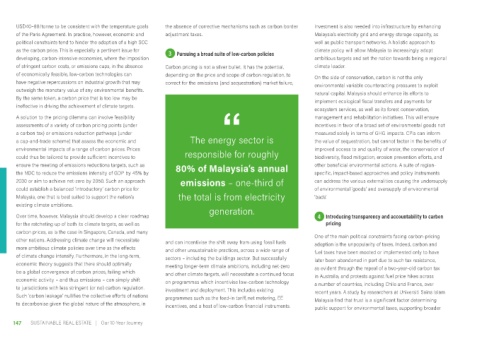Page 158 - GreenRE_Sustainable Real Estate Book
P. 158
USD40–80/tonne to be consistent with the temperature goals the absence of corrective mechanisms such as carbon border Investment is also needed into infrastructure by enhancing
of the Paris Agreement. In practice, however, economic and adjustment taxes. Malaysia’s electricity grid and energy storage capacity, as
political constraints tend to hinder the adoption of a high SCC well as public transport networks. A holistic approach to
as the carbon price. This is especially a pertinent issue for 3 Pursuing a broad suite of low-carbon policies climate policy will allow Malaysia to increasingly adopt
developing, carbon-intensive economies, where the imposition ambitious targets and set the nation towards being a regional
of stringent carbon costs, or emissions caps, in the absence Carbon pricing is not a silver bullet. It has the potential, climate leader.
of economically feasible, low-carbon technologies can depending on the price and scope of carbon regulation, to On the side of conservation, carbon is not the only
have negative repercussions on industrial growth that may correct for the emissions (and sequestration) market failure, environmental variable counteracting pressures to exploit
outweigh the monetary value of any environmental benefits. natural capital. Malaysia should enhance its efforts to
By the same token, a carbon price that is too low may be implement ecological fiscal transfers and payments for
ineffective in driving the achievement of climate targets. ecosystem services, as well as its forest conservation,
A solution to the pricing dilemma can involve feasibility management and rehabilitation initiatives. This will ensure
assessments of a variety of carbon pricing points (under “ incentives in favor of a broad set of environmental goods not
a carbon tax) or emissions reduction pathways (under measured solely in terms of GHG impacts. CPIs can inform
a cap-and-trade scheme) that assess the economic and The energy sector is the value of sequestration, but cannot factor in the benefits of
environmental impacts of a range of carbon prices. Prices improved access to and quality of water, the conservation of
could thus be tailored to provide sufficient incentives to responsible for roughly biodiversity, flood mitigation, erosion prevention efforts, and
ensure the meeting of emissions reductions targets, such as 80% of Malaysia’s annual other beneficial environmental actions. A suite of region-
the NDC to reduce the emissions intensity of GDP by 45% by specific, impact-based approaches and policy instruments
2030 or aim to achieve net-zero by 2050. Such an approach emissions – one-third of can address the various externalities causing the undersupply
could establish a balanced ‘introductory’ carbon price for of environmental ‘goods’ and oversupply of environmental
Malaysia, one that is best suited to support the nation’s the total is from electricity ‘bads’.
existing climate ambitions. generation.
Over time, however, Malaysia should develop a clear roadmap 4 Introducing transparency and accountability to carbon
for the ratcheting up of both its climate targets, as well as pricing
carbon prices, as is the case in Singapore, Canada, and many One of the main political constraints facing carbon-pricing
other nations. Addressing climate change will necessitate and can incentivise the shift away from using fossil fuels adoption is the unpopularity of taxes. Indeed, carbon and
more ambitious climate policies over time as the effects and other unsustainable practices, across a wide range of fuel taxes have been mooted or implemented only to have
of climate change intensify. Furthermore, in the long-term, sectors – including the buildings sector. But successfully later been abandoned in part due to such tax resistance,
economic theory suggests that there should optimally meeting longer-term climate ambitions, including net-zero as evident through the repeal of a two-year-old carbon tax
be a global convergence of carbon prices, failing which and other climate targets, will necessitate a continued focus in Australia, and protests against fuel price hikes across
economic activity – and thus emissions – can simply shift on programmes which incentivise low-carbon technology a number of countries, including Chile and France, over
to jurisdictions with less stringent (or no) carbon regulation. investment and deployment. This includes existing recent years. A study by researchers at Universiti Sains Islam
Such ‘carbon leakage’ nullifies the collective efforts of nations programmes such as the feed-in tariff, net metering, EE Malaysia find that trust is a significant factor determining
to decarbonise given the global nature of the atmosphere, in incentives, and a host of low-carbon financial instruments. public support for environmental taxes, supporting broader
147 SUSTAINABLE REAL ESTATE | Our 10-Year Journey

